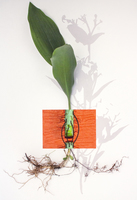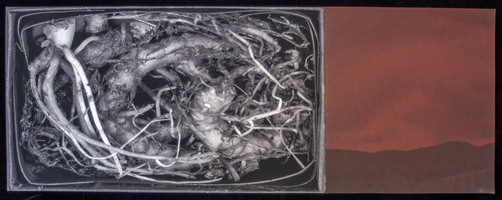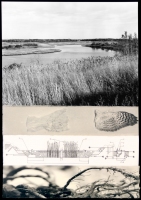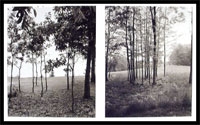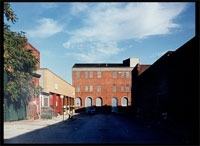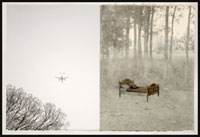Mariah Doren and Johanna Paas- Nature’s Math In this collaborative series of mixed media prints we use mathematics as a symbolic system for understanding, describing, interpreting and re-presenting the world. The images feature natural objects—rotting wood or a tangle of roots—and explore the establishment of order that math suggests. At times, this imposition is obvious; we draw on the landscape with rope, or literally overlay the formula that describes the curve of a branch or the radius of a drop of water. At other times, the relationship between object and formula is subtler: a cracked walnut that mirrors the unit circle, or a Mercator projection that maps layered clouds. We start by choosing a concept with metaphoric potential, the suggestion of experiences that stretch beyond representation in numerical terms. Pi (π): infinite, constant yet irrational, perfection Cosine: inverse relationships, the finding of self in relation to other, opposite yet codependent. Natural log (Ln): exponential growth or decay, how one thing builds upon itself. The mathematical constant (e): transcendent and uncountable, maps and measures distance. The formulas serves as boundary. Listed attributes function as rules for collecting material—objects, representations, and diagrams—that reference the natural world. Our photographs and prints are layered, stitched, and combined. The collage of recontextualized images is an exploration of order, the balance between discovery and imposition.
Grafting is a series of mixed-media prints that examine techniques used in horticulture to join different plants to each other. In this collaborative series, we explore grafting as a symbolic system for describing, interpreting, and re-presenting the idea of connection and dislocation. The images feature specific plants—a real version and a fake one— that are conjoined in different ways and loosely trace varied reasons for grafting; mending damaged trunks, combining plants to create hybrid fruits, and propagating new plants from a single source. The images are multilayered combinations of silkscreen and photographs that play with scale, vantage point, and color to create purposeful incongruencies.
This series of landscape images play with the idea of scale, value, and vantage point. Moving from warm to cool, macro to micro in order to re-see land around us that seems often unchanging and familiar.
Mariah Doren-Constructed landscapes
Photographing constructed landscapes is an integral part of my work, I play with the elusive ideal of the natural by making images of places that have been highly manipulated and cultivated. I start with photographs of capped landfills, layers are added, re-assembling and re-imagining what could lie beneath. In another instance I use a plowed cornfield and sew the lines of cropped stalks back in to the image, to make a shelter for a baby deer. The location, place or moment described is visually constructed using fragments of photographs, drawings or printed material. Fragments are purposefully discontinuous or grotesquely out of scale so the connections that bind the image rely on fantasy, dreams or idiosyncratic associations. At the same time the surface of these images are lush: palladium prints, waxed, sewn, painted or printed upon. These images push the idea of construction in two directions simultaneously; the collaged image of manmade landscapes.
Photographing constructed landscapes is an integral part of my work, I play with the elusive ideal of the natural by making images of places that have been highly manipulated and cultivated. I start with photographs of capped landfills, layers are added, re-assembling and re-imagining what could lie beneath. In another instance I use a plowed cornfield and sew the lines of cropped stalks back in to the image, to make a shelter for a baby deer. The location, place or moment described is visually constructed using fragments of photographs, drawings or printed material. Fragments are purposefully discontinuous or grotesquely out of scale so the connections that bind the image rely on fantasy, dreams or idiosyncratic associations. At the same time the surface of these images are lush: palladium prints, waxed, sewn, painted or printed upon. These images push the idea of construction in two directions simultaneously; the collaged image of manmade landscapes.
The False Diptych Series is a comparison of landscapes but is also a theoretical project where the role of the observer is posited against our received notions of landscape. The compositions pair seemingly continuous views of the same constructed landscape, usually golf courses, which are actually images from different locations. The photographs are paired as a diptych that seems like one picture cut in half. The relationships between the objects in the images, and relationships between the separate pieces themselves, are central and carefully constructed. I use formal aspects, light, angle of view and horizon lines to bind one half-image to the other. They are superficially a pair: two pictures, one scene.Photographing constructed landscapes is an integral part of my work. The ideal of the natural is elusive and the legibility and clear geometry of constructed places seems more “perfect” than pristine nature itself. I use the palladium process to allude to 19th century Pictorialism, a romantic period of image making, that further pushing the artifice of the compositions
The Build-a-Park Series extends from the comparison of landscapes. The compositions combine three seemingly continuous views of the same constructed landscape, but are photographs of golf courses in different locations. The reference in this series to 19th Century Romantic landscape design is more direct, using Frederick Law Olmstead’s vision of ideal progress through a park—start with a meadow, then move into the ramble and end with a water view.
The Gowanus Canal Series is a collection of images that describe a canal in Brooklyn near where I lived. Walking through the neighborhood I made these images as I reflected on the rich history of a now derelict industrial waterway. Oysters from the canal were one of Brooklyn’s earliest exports to Europe, and today it must be on the top ten list of most polluted bodies of water in the United States. The water, which I have never touched, has been described as being like black mayonnaise.
In these works the preciousness of specific moments are artificially inserted and singled out with the addition of a picket fence for a single tree or a vase for a curved sapling. The images are clearly divided in halves with layers of varying transparency, weight and use of space.

